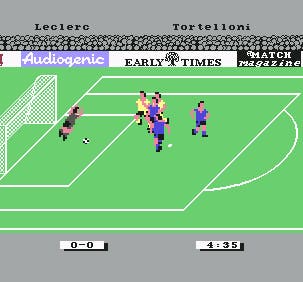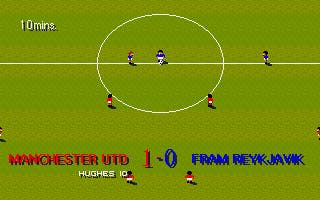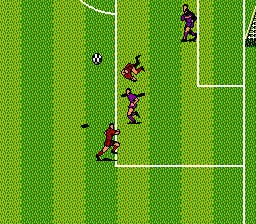It Really Is All Over
And we're sick of PES and FIFA. So what are our other footballing options?
Extra time!
Kristan reaches under the bed and picks through a few of his old favourites. And ones he just felt like slagging off.
International Soccer (C64)
Commodore, 1983
One of the early 'system sellers' for the C64, Andrew Spencer's seminal title came bundled with the ridiculously expensive machine on a cartridge (as opposed to cassette) and ensured that the large majority of the early adopters had this game nestling somewhere in their collection. Featuring chunky graphics that were pretty unacceptable even then, this was nevertheless a pivotal title in the genesis of footy titles 'back in the day' for its (then) revolutionary touchline camera view and neat use of smooth scrolling to deliver the first title that got anywhere close to resembling real-life footy. Seen through today's eyes it still has a certain clueless charm about it, with hilarious ball physics that let you run the full length of the pitch with the ball bouncing on your head, and that old one button control system that we still love today. And let's not forget that the C64's built-in joystick support made it one of the two-player sport games of the mid '80s.
Match Day (Spectrum 48k - ported to BBC, C64 and Amstrad)
Ocean, 1984
A retro classic! Actually that's a terrible lie. Match Day is terrifyingly awful through today's eyes, but it scored Ocean (and Head Over Heels creator Jon Ritman) a massive hit back in 1984 by virtue of being the Speccy's first footy title of any note. Essentially based on Commodore's successful International Soccer, it favoured the touchline cam still used today and amused many with its burbling rendition of the 'Match of the Day' theme tune as the players emerged from the tunnel in all their two-frames of animation glory (borrowed from their previous title Bear Bovver!). But if the flickery, colour clash-prone graphics, jerky scrolling and gaudy pitch colour didn't fry your brain, then the incredible absence of anything resembling ball physics made the process of actually playing the game a bit of a lottery. Still has a place in many 30-somethings hearts, but one that's best left in the mind's eye. Don't even think about firing up the emulator - and ignore the ports at all costs. According to Jon Ritman, "The versions for the BBC, C64 and Amstrad CPC were programmed by others who didn't even talk to me about it - I thought the versions were dire."
The inevitable sequel appeared three years later, adding a whole bunch of new features that allowed control over the power of your shot and headers and is arguably the best Speccy footy title ever. Again, try and avoid the ports if you can. They'll only break your heart.
Emlyn Hughes International Soccer (C64 - ported to Spectrum 48k, Amstrad, Atari ST, and Amiga)
Audiogenic 1988

Some five years after the 'daddy', Graham Blighe and co returned to the source inspiration to create what many considered to be the best footy title of the '80s. Originally conceived for the C64, it trod a satisfying middle ground between the frantic speed of arcade footy titles of the era (and latterly Kick Off) and the slower paced Match Day II to great effect. Deceptively simple on the surface, the controls were surprisingly sophisticated, allowing players to cross the ball for the first time. In addition, it was the first footy title to include pseudo management elements, with the ability to rename players and change the colour of the strip, while cup and league options gave the game a long-term appeal that was completely alien at the time. Visually it was blocky as hell (especially at a time when most developers had really nailed the C64s hidden depths) but there's a great deal of fondness reserved for this game, and rightfully so.
Microprose Soccer (C64 - ported to Spectrum 48k, Amstrad, Atari ST, and Amiga)
Microprose, 1988
The oft-forgotten 'original' Sensible Soccer was a revelation at the time, bringing sharp, colourful top-down visuals and endless playability to the C64. Bundled with an indoor and outdoor version, it included a whole array of features such as banana shots, lobs, sliding tackles and instant replays that contributed to a hugely entertaining package that still holds its own today (if you're being kind, which we are). Admittedly, the ludicrous giant ball, large players and massively disruptive sliding tackles turn the game into a curious spectacle, but a lot of its instant playability contributed to the later success of Sensible Soccer four years later.
Street Sports Soccer (C64 and Apple II)
Epyx

Part of Epyx's long-forgotten Street Sports series (that also included the rather brilliant Basketball and less interesting Baseball), this was the first ever 'street' attempt at the beautiful game, long before EA's FIFA Street corrupted an entire generation with its attempts at getting down with da kidz, innit. Epyx was unfortunately on a bit of a downward spiral by the time this came out, and reviews were rather unenthusiastic. Rightly so - the visuals were chunky and lazy, the gameplay uninspired and the whole idea rather 'back of a beermat' material. Choosing the best three players from a cast of nine sounded like a good idea, but it played pretty badly. Avoid.
Kick Off 2 (Amiga - ported to PC, Atari ST, SNES, Mega Drive, C64, Spectrum 48k and Amstrad)
Anco, 1990
A vast improvement on the 1989 original, Dino Dini's all-time top down classic threw aftertouch and more pitch types into the mix and created a legend that's still a hot forum topic even today. Taking an almost pinball-esque approach to football, it put speed and instinct right at the core of the game and introduced a radical control system that took an age to truly get to grips with. Players almost acted like running 'bats', with the ball bouncing off you as you ran. You could trap the ball and lay it off with skill, but in general the game flowed better by 'scooping' the ball, beating your man for pace and curling a shot (using the superb aftertouch) in as the keeper ran out. Featuring some hilarious bugs (like the ability to lob the keeper every time from near the halfway line), a clunky front end and rudimentary presentation, this was nevertheless one of the pivotal footy games that kept us going for the first half of the decade. Dino Dini's finest hour.
Sensible Soccer (Amiga - ported to Atari ST, Mega Drive, SNES and PC)
Renegade, 1992

Having completed work on 1991 strategy title Mega-lo-mania, Sensible Software stumbled on the realisation that the charming miniature visual style they pioneered would work brilliantly in a footy game. A few months later a legend was born, taking many of the ideas from 1988's Microprose Soccer, zooming out the pitch view, upping the tempo two-fold and creating one of the most free-flowing footy titles of all time. Unlike Kick-Off 2, it was immediately apparent that a passing game was key to any success, and this crucial design decision made it by far the easiest game to pick up and play of its ilk. With stunning precision, you could quickly string complex patterns of play around the park, pulling off deft lobs, quick passes and scorching volleys and headers with aplomb, and remains one of the most refined control systems ever. Six subsequent versions were released over the next five years on the Amiga (five also on the PC), the latter of which many regard as the best footy games of the '90s. Rumours persist that Codemasters is planning to revive a 'classic' Sensible Soccer for release via Xbox Live Arcade. We live in hope...
Striker (Amiga - ported to Atari ST, Mega Drive and SNES)
Rage, 1992
Why this ever got the rave reviews it did, we'll never know. The curious 3D 'run into the pitch' viewpoint was somewhat revolutionary at the time, and the speed was impressive, but this didn't make it remotely possible to play a decent, flowing game of football. Looking back, it was one of those games which we all tried to get into but quickly abandoned to play some Kick-Off 2 or Sensible.
Hyper Soccer (NES)
Konami, 1992

Konami's top-down foray into the world of footy. Largely because the NES was (originally) a bit of a forgotten platform in the UK this didn't even register with most of us over here, but hilariously it has a top-down viewpoint with side-on players - as if they're lying on their sides on the pitch. You've gotta love the 8-bit. Let us know what it was like, won't you?
Goal! (Amiga - ported to Atari ST and PC)
Virgin, 1993
Dino Dini's long awaited follow-up to Kick-Off 2 was considered a bit of a disappointment upon its eventual release (at least with the consumers - reviews were positive enough), but still stands as one of the best top-down footy games of the era. Taking the bold step of basing the entire control system around pass-and-move, there was a much greater emphasis on trapping the ball before laying it off to another player. Rather oddly, you spent much of the time holding the fire button down in order to first trap the ball, then quickly rotated your man to the direction you wanted to pass to and then eventually let go to spray the pass (then quickly pressing the button again to make sure you trapped the ball). It felt more sophisticated that the Kick-Off games at first, but was lacking a crucial spark despite technically being one of the most technically impressive footy game of the 16-bit era.
Perhaps the killer blow about Goal was the fact that - once you got the hang of the unusual control system - it was a piece of cake to score, and therefore removed the indefinable randomness of playing "the greater leveller" that was Kick-Off 2. After Goal and the related Dino Dini's Soccer (for Mega Drive the following year), his next footy project was cancelled in 1996, while he didn't cover himself in glory with his involvement with Z-Axis' forgettable Three Lions (incredibly, a No.1 hit) for Take-Two. He formed Abundant Software in Bristol in 2001 and started work on the 'Soccer 3' project for DC Studios (giving himself the characteristically big-headed title of the "Godfather of the footy title" while managing to ignore everything that came before Kick-Off), but little has been heard since this interview two years ago. His website appears solely focused on his musical ambitions these days (and freely admits he was never a footy fan), with literally no mention of any of his current gaming project. Answers on a postcard, etc...








